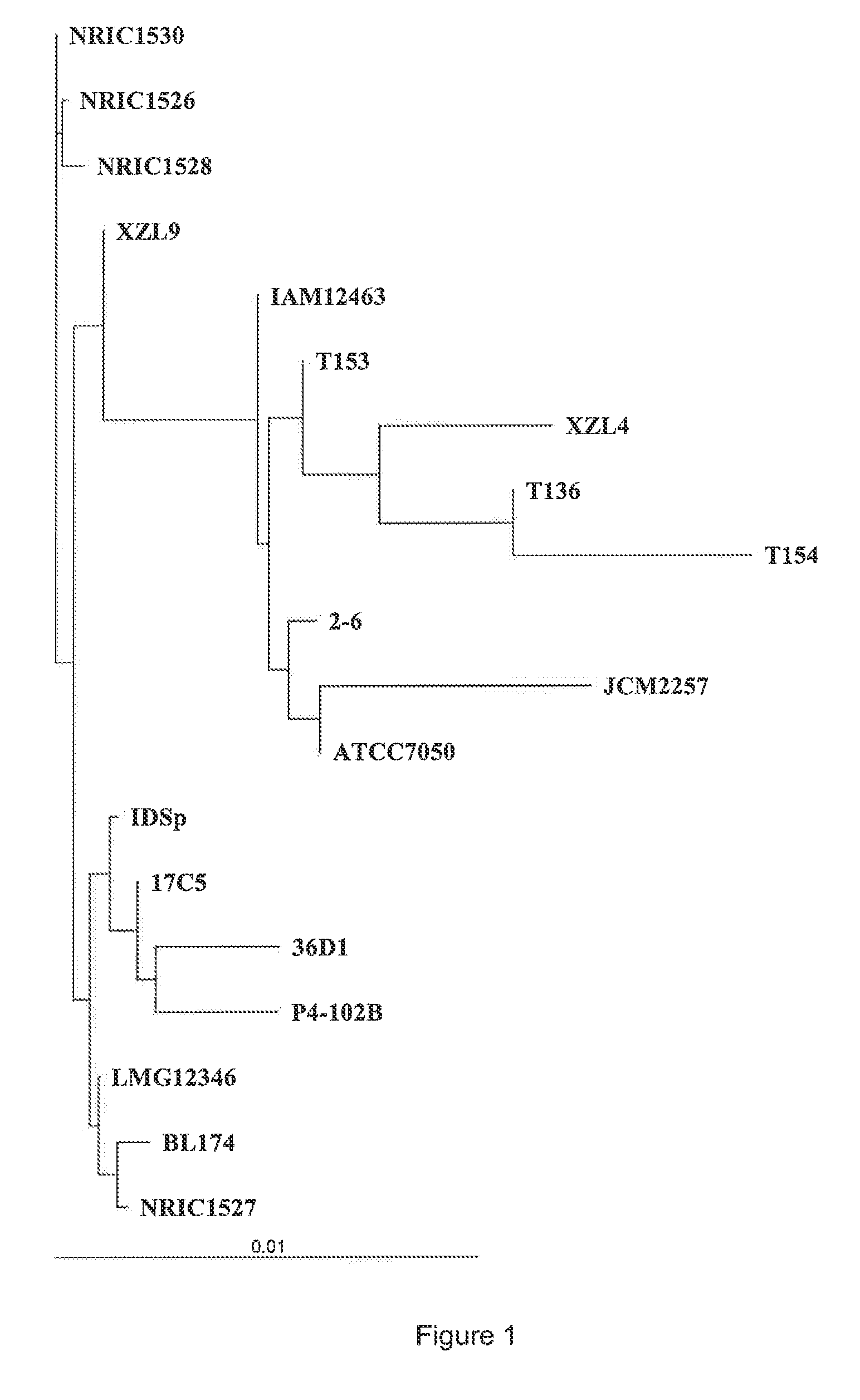Bacillus coagulans strains and their applications in l-lactic acid production
- Summary
- Abstract
- Description
- Claims
- Application Information
AI Technical Summary
Benefits of technology
Problems solved by technology
Method used
Image
Examples
example 1
[0062]Batch fermentation of L-lactic acid from glucose by using B. coagulans XZL4 DSM No. 23183 and XZL9 DSM No. 23184 in flasks:
[0063]The media compositions of the example are as follows:
[0064]Slant medium per liter contains: xylose 30 g, yeast extract 10 g, CaCO3 10 g, agar 15 g, and water. The pH value of the slant medium is 6.5. Sterilization is conducted at 115° C. for 20 minutes.
[0065]Seed medium per liter contains: glucose 50 g, yeast extract 10 g, CaCO3 20 g, and water. The pH value of the medium is 6.5. Sterilization is conducted at 115° C. for 20 minutes.
[0066]Fermentation media per liter contain: glucose 55-150 g, yeast extract 10 g, CaCO3 60 g, and water. The pH value of the medium is in the range 5.5-7. Sterilization is conducted at 115° C. for 20 minutes.
[0067]The method for L-lactic acid production in the invention includes the following procedures:
[0068](1) Slant culture: B. coagulans XZL4 (DSM No, 23183) and XZL9 (DSM No. 23184) were inoculated into slant medium and...
example 2
[0073]Batch fermentation of L-lactic acid from xylose by using B. coagulans XZL4 DSM No. 23183 and XZL9 DSM No. 23184 in flasks:
[0074]The media compositions of the example are as follows:
[0075]Slant medium and seed medium are the same as in example 1.
[0076]Fermentation medium per liter contains: xylose 55-100 g, yeast extract 10 g, CaCO3 60 g, and water. The pH value of the medium is in the range 5.5-7. Sterilization is conducted at 115° C. for 20 minutes.
[0077]The method for Lactic acid production in the invention includes the following procedures:
[0078](1) Slant culture: as in example 1;
[0079](2) Seed culture: as in example 1;
[0080](3) Fermentation culture: as in example 1.
[0081]Fermentation was stopped when the contents of L-lactic acid and glucose were steady. L-lactic acid and glucose concentrations were measured, and L-lactic acid productivities were calculated according to the methods mentioned above.
[0082]The experiment was conducted in triplicate. The results are shown in T...
example 3
[0083]Batch fermentation of L-lactic acid from xylitol byproducts by using B. coagulans XZL4 DSM No. 23183 and XZL9 DSM No. 23184 in flasks:
[0084]The media compositions of the example are as follows:
[0085]Slant medium and seed medium are the same as in example 1.
[0086]Fermentation medium per liter contains: xylitol 75-150 g, yeast extract 10 g, CaCO3 60 g, and water. The pH value of the medium is in the range 5.5-7. Sterilization is conducted at 115° C. for 20 minutes.
[0087]The method for L-lactic acid production in the invention includes the following procedures:
[0088](1) Slant culture: as in example 1;
[0089](2) Seed culture: as in example 1;
[0090](3) Fermentation culture: 10 mL of seed cultures from procedure (2) was inoculated into a 300-mL flask containing 90 mL fermentation medium and statically fermented at 50° C. for 48 hours.
[0091]After the fermentation was stopped, the amounts of L-lactic acid and total reducing sugar were measured, and L-lactic acid productivities were cal...
PUM
| Property | Measurement | Unit |
|---|---|---|
| Temperature | aaaaa | aaaaa |
| Length | aaaaa | aaaaa |
| Length | aaaaa | aaaaa |
Abstract
Description
Claims
Application Information
 Login to View More
Login to View More - R&D
- Intellectual Property
- Life Sciences
- Materials
- Tech Scout
- Unparalleled Data Quality
- Higher Quality Content
- 60% Fewer Hallucinations
Browse by: Latest US Patents, China's latest patents, Technical Efficacy Thesaurus, Application Domain, Technology Topic, Popular Technical Reports.
© 2025 PatSnap. All rights reserved.Legal|Privacy policy|Modern Slavery Act Transparency Statement|Sitemap|About US| Contact US: help@patsnap.com



